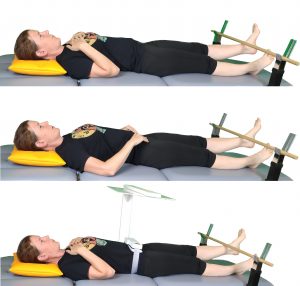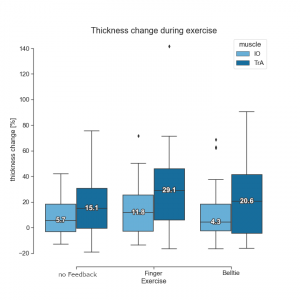Development and Evaluation of an Audio-Feedback-Device for Pelvic Movements in the Transversal Plane During the Active Straight Leg Raise by Ultrasound Thickness Measurement of Deep Abdominal Muscles – a Pilot Study
Aim and Research Question(s)
The aim of this study was to develop a prototype audio feedback device for exercises that require rotational stability of the pelvis. It was evaluated how the use of this device during Active Straight Leg Raise (ASLR) influences muscle thickness of Transversus Abdominis (TrA) and Internal Oblique (IO). Further, the newly built feedback device was compared to a feedback method with the subject's own fingers on the pelvis.
Background
Deep abdominal muscles TrA and IO are more active when the pelvis rotates less during the ASLR and feedback methods on pelvic position showed to be effective. (Park et al., 2013; Noh et al. 2014). Conscious activation of deep abdominal muscles leads to less pelvic rotation during ASLR (Liebenson et al., 2009).
Methods
 20 healthy subjects performed an ASLR without feedback of their pelvis position, an ASLR with their own fingers on the anterior-superior iliac spine as tactile feedback of their pelvis position and an ASLR with the newly built Belltie feedback device. During all exercises, the thickness of TrA and IO was measured by ultrasound imaging and the percent thickness change to the measurement at rest was calculated. The results were described with descriptive statistics.
20 healthy subjects performed an ASLR without feedback of their pelvis position, an ASLR with their own fingers on the anterior-superior iliac spine as tactile feedback of their pelvis position and an ASLR with the newly built Belltie feedback device. During all exercises, the thickness of TrA and IO was measured by ultrasound imaging and the percent thickness change to the measurement at rest was calculated. The results were described with descriptive statistics.
Results and Discussion
Data show a tendency to increased thickness change of TrA and IO in ASLR with feedback as compared to ASLR without feedback. Comparing the two feedback methods, a tendency for slightly more muscle thickness increase was found during the ASLR with the finger feedback method as when using the Belltie feedback device. High standard deviations indicate large individual differences. As an additional finding, a trend toward better ability of rotational pelvis control in ASLR on the dominant leg side as compared to the non-dominant leg side was observed.

Conclusion
The newly built feedback device shows a tendency to recruitment of the abdominal muscles TrA and IO when used during the ASLR and could therefore be a helpful device in physiotherapy or specific training of TrA and IO.
References
Park et al. (2013). Effects of the pelvic rotatory control method on abdominal muscle activity and the pelvic rotation during active straight leg raising. https://doi.org/10.1016/j.math.2012.10.004, Noh et al. (2014). https://doi.org/10.1589/jpts.26.717 Liebensonet al. (2009). https://doi.org/10.1016/j.pmrj.2009.03.007
